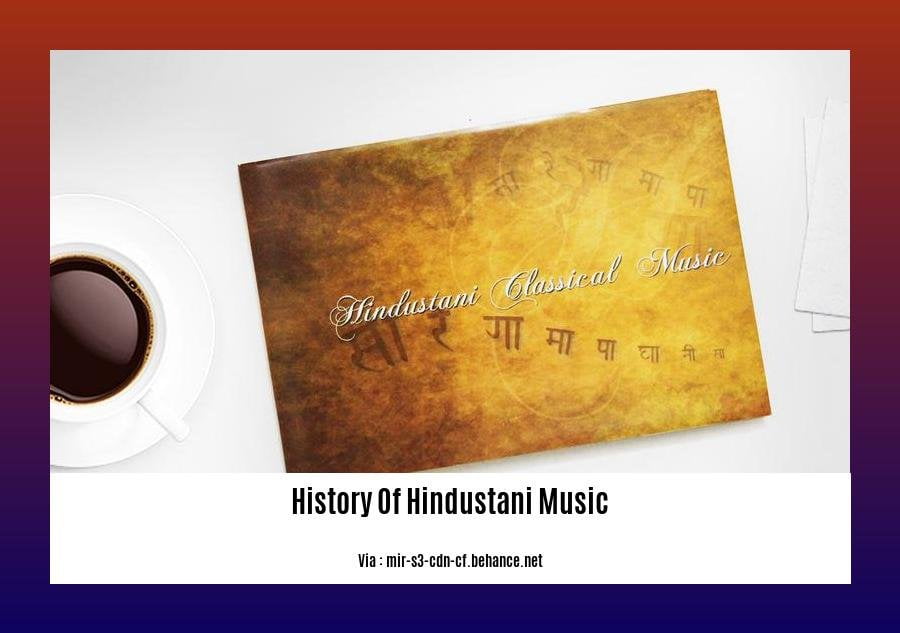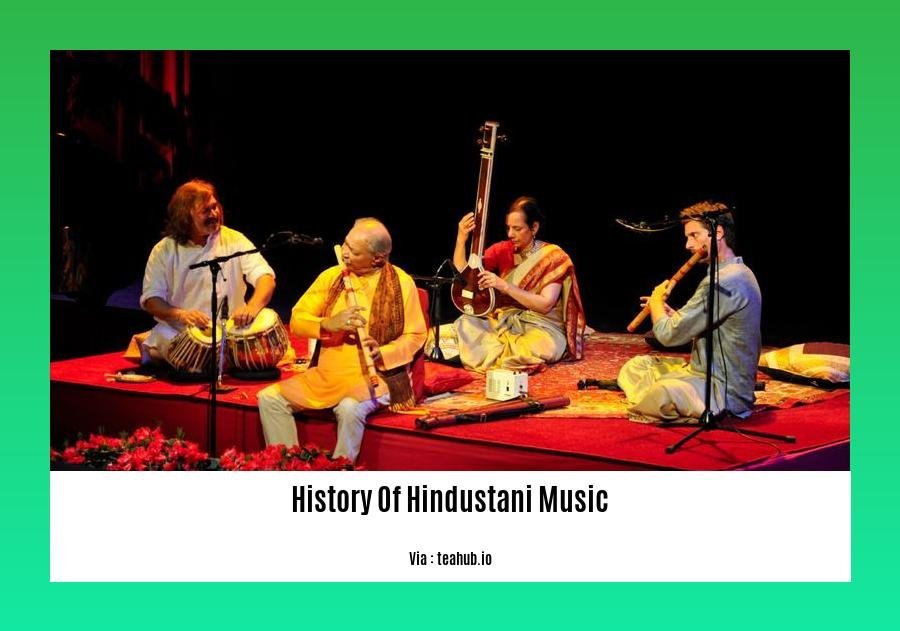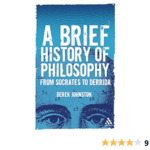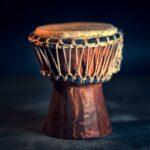Immerse yourself in the mesmerizing journey of Hindustani music, a captivating tradition that has enthralled audiences for centuries. From its ancient origins to its vibrant modern-day renditions, we embark on an exploration of the rich tapestry of Hindustani music, tracing its evolution through the prism of history, culture, and society. Prepare to be captivated as we unveil the profound narrative of this musical masterpiece, [A Journey Through Time: Unveiling the Profound History of Hindustani Music].
Key Takeaways:
Hindustani music originated in the 12th century CE in North India.
Influenced by ancient Hindu tradition, Vedic philosophy, Persian tradition, Arab, Persian, and Afghan cultures.
Rooted in Vedic literature of Hinduism and emerged as a distinct art form.
One of the two main types of South Asian classical music, primarily found in Northern India.
Compositions use various languages including Sanskrit, Hindi, Punjabi, Rajasthani, Urdu, and Braj Bhasha.
History of Hindustani Music

Hindustani music, a vibrant tapestry of sound, is a testament to the rich cultural heritage of North India. Rooted in ancient traditions, it weaves together diverse influences to create a musical journey that is both captivating and profound.
Early Influences
The origins of Hindustani music can be traced back to the Vedic era, where it was a fundamental part of religious rituals. The Samaveda, one of the four Vedas, is dedicated to the study of music, chanting, and melodies used in Vedic ceremonies.
The Transformation
Over time, Hindustani music evolved beyond its religious associations, absorbing influences from various cultures that shaped the Indian subcontinent. The arrival of Islam in the 12th century brought new musical elements, such as the use of the sitar and tabla, which became integral to Hindustani music.
The Mughal Empire
The Mughal Empire played a significant role in the development of Hindustani music, providing patronage to musicians and encouraging the exchange of ideas between different musical traditions. The Mughal courts became vibrant centers of musical innovation, where renowned musicians from across the empire gathered to showcase their talents.
The 20th Century
The 20th century witnessed a revival of interest in Hindustani music, spearheaded by legendary musicians such as Ustad Amir Khan, Ustad Bade Ghulam Ali Khan, and Pandit Ravi Shankar. These maestros not only preserved the traditional forms of Hindustani music but also pushed the boundaries of innovation, creating new compositions and styles that captivated audiences worldwide.
Diverse Influences on Hindustani Music
| Sources of Influence | Key Contributions |
|---|---|
| Hindu traditions | – Emphasis on spirituality and devotion |
| Vedic philosophy | – Development of rhythmic patterns and melodies |
| Persian tradition | – Introduction of the sitar, tabla, and other instruments |
| Arab, Persian, and Afghan | – Use of ornamentation and improvisation |
Conclusion
Hindustani music stands as a testament to the enduring power of tradition, innovation, and cultural exchange. Its journey through history has been marked by the contributions of countless musicians, rulers, and patrons who have nurtured and shaped this vibrant art form. As we continue to explore the depths of Hindustani music, we uncover a legacy that is both timeless and infinitely captivating.
Explore our exquisite collection of history of Ireland bracelets, showcasing the rich heritage and captivating stories of the Emerald Isle. Discover the unique craftsmanship and symbolism behind each piece of history of Ireland jewelry, reflecting the country’s vibrant culture and traditions. Adorn yourself with a history of Ireland ring, a timeless symbol of Irish pride and connection to its storied past.
Hindustani Classical Music: A Cultural Odyssey

Key Takeaways
– Evolved from Ancient Traditions: Hindustani music traces its roots to ancient Vedic literature, merging Hindu traditions with influences from Persia, Arabia, and Afghanistan.
– Distinct Language Use: While Carnatic music primarily uses compositions in South Indian languages, Hindustani music features compositions in Hindi, Punjabi, Rajasthani, Urdu, and Braj Bhasha.
– Diverse Styles: Many regional variations, known as gharanas, contribute to the rich diversity of Hindustani classical music, each with its unique style and approach.
– Oral Transmission: Traditionally transmitted orally from guru to disciple, Hindustani music emphasizes face-to-face interaction and personalized instruction.
– Improvisation and Expression: Hindustani music places a high value on improvisation, allowing performers to showcase their creativity and emotional expressiveness within the framework of ragas and talas.
Throughout the tapestry of Indian musical heritage, Hindustani Classical Music stands as a beacon of cultural and artistic achievement. Rooted in the convergence of Vedic wisdom, Persian aesthetics, and diverse regional influences, this vibrant tradition has captured the hearts of music enthusiasts for centuries. Join us on a voyage through time as we unravel the enthralling history of Hindustani Classical Music.
A Historical Tapestry: The Making of a Musical Masterpiece
The origins of Hindustani Classical Music can be traced back to ancient India, where Vedic hymns and chants laid the foundation for a rich musical lineage. Over time, this musical legacy intertwined with influences from Persia, Arabia, and Afghanistan, resulting in a unique amalgamation of sounds and styles. The 12th century marked a significant turning point, as Hindustani Classical Music diverged from its southern counterpart, Carnatic music, forging its own path of musical expression.
Diverse Languages, United by Melody
A distinctive feature of Hindustani Classical Music is its use of various languages for compositions. While Carnatic music predominantly employs South Indian languages, Hindustani Classical Music embraces a diverse range of languages, including Hindi, Punjabi, Rajasthani, Urdu, and Braj Bhasha. This linguistic diversity reflects the vast cultural landscape of the northern regions of the Indian subcontinent, where Hindustani Classical Music has flourished.
Gharanas: A Symphony of Styles
The world of Hindustani Classical Music is further enriched by the existence of numerous gharanas, or musical lineages. Each gharana represents a unique style or approach to music, passed down from generation to generation through a rigorous system of oral transmission. The concept of gharanas ensures that the rich heritage of Hindustani Classical Music is preserved and nurtured, with each gharana contributing its distinct flavor to the overall tapestry of the genre.
Oral Transmission: The Guru-Shishya Parampara
In the realm of Hindustani Classical Music, the guru-shishya parampara, or the teacher-disciple tradition, holds immense significance. This traditional method of knowledge transmission involves face-to-face interactions between the guru and the shishya, or student. Through this intimate relationship, the guru imparts not only musical knowledge but also the values, philosophies, and techniques that define Hindustani Classical Music.
Improvisation and Expression: A Journey of Creativity
One of the defining characteristics of Hindustani Classical Music is its emphasis on improvisation. Within the framework of ragas and talas, performers are given the freedom to explore their creativity and express their emotions through spontaneous musical renditions. This ability to improvise sets Hindustani music apart from many other musical traditions, allowing performers to showcase their virtuosity and unique artistic interpretations.
Conclusion: A Living Legacy
Hindustani Classical Music stands as a testament to the enduring power of cultural heritage. Rooted in ancient traditions, it has evolved and adapted over time, embracing diverse influences and nurturing a vibrant ecosystem of regional styles. Through its emphasis on oral transmission, improvisation, and emotional expression, Hindustani Classical Music continues to captivate audiences, ensuring its legacy as a living and breathing art form.
References:
– Hindustani Classical Music – Wikipedia
– Hindustani Classical Music – Indian Music Society
History[edit]
Hindustani music, a captivating blend of tradition and innovation, has a rich and storied past. It emerged in the 12th century, tracing its lineage to the classical music of North India. Let’s delve into the captivating history that shaped this magnificent tradition:
Ancient Roots: Hindustani music finds its roots in the ancient Vedic literature of Hinduism, the oldest known scriptures. It blossomed from Vedic chants, evolving into a distinct genre of art that mirrors the evolution of modern music.
North Indian Heritage: In the 12th century, Hindustani music diverged from its southern counterpart, Carnatic music, forming a unique classical tradition in North India. It is one of the two main types of classical music in South Asia, each with its distinct characteristics.
Cultural Influences: Over the centuries, Hindustani music absorbed diverse influences from the cultures it encountered. Persian, Arab, and Afghan traditions left an indelible mark on its melodies, rhythms, and instruments. This cross-cultural exchange enriched Hindustani music, adding layers of complexity and depth.
Guru-Shishya Tradition: Hindustani music has been traditionally passed down from guru to shishya (teacher to student) through a system of oral transmission. This gurukul system emphasized face-to-face interactions, personalized guidance, and a deep bond between teacher and student, ensuring the preservation and evolution of the tradition.
Regional Gharanas: Over time, regional variations emerged within Hindustani music, giving rise to gharanas, or musical lineages. Each gharana developed its unique style, approach, and repertoire, contributing to the vibrant diversity of the tradition.
Innovation and Improvisation: Hindustani music is known for its emphasis on improvisation and emotional expression. Within the framework of ragas and talas, performers are encouraged to explore their creativity and interpret the music in their unique way. This improvisatory aspect keeps the tradition dynamic and ever-evolving.
Key Takeaways:
Hindustani music emerged in the 12th century, evolving from ancient Vedic chants.
It diverged from Carnatic music, creating a unique North Indian classical tradition.
Hindustani music absorbed influences from Persian, Arab, and Afghan cultures, enriching its repertoire.
The guru-shishya tradition ensured the transmission of knowledge and the preservation of the tradition.
Regional gharanas added diversity to Hindustani music, with each gharana developing its unique style.
Improvisation and emotional expression are key elements of Hindustani music, allowing for creativity and personal interpretation.
Sources:
[1] Hindustani Classical Music – Wikipedia
[2] Hindustani Music – दृष्टि आईएएस
FAQ
Q1: What is the origin of Hindustani Music?
A1: Hindustani music originated in the 12th century CE in North India as a branch of Carnatic music, the classical music tradition of South India.
Q2: What are the influences on Hindustani Music?
A2: Hindustani music incorporates elements of Vedic philosophy, ancient Hindu tradition, Persian, Arab, and Afghan influences.
Q3: How did Hindustani Music evolve from ancient Indian music?
A3: Hindustani music evolved from the Vedic literature of Hinduism in ancient India, developing into a distinct genre of art equivalent to contemporary music.
Q4: What are the two main types of South Asian classical music?
A4: Hindustani music and Carnatic music are the two main types of South Asian classical music.
Q5: What languages are used in Hindustani Music compositions?
A5: Hindustani music uses various languages in its compositions, including Sanskrit, Kannada, Telugu, Tamil, Malayalam, Hindi, Punjabi, Rajasthani, Urdu, and Braj Bhasha.












